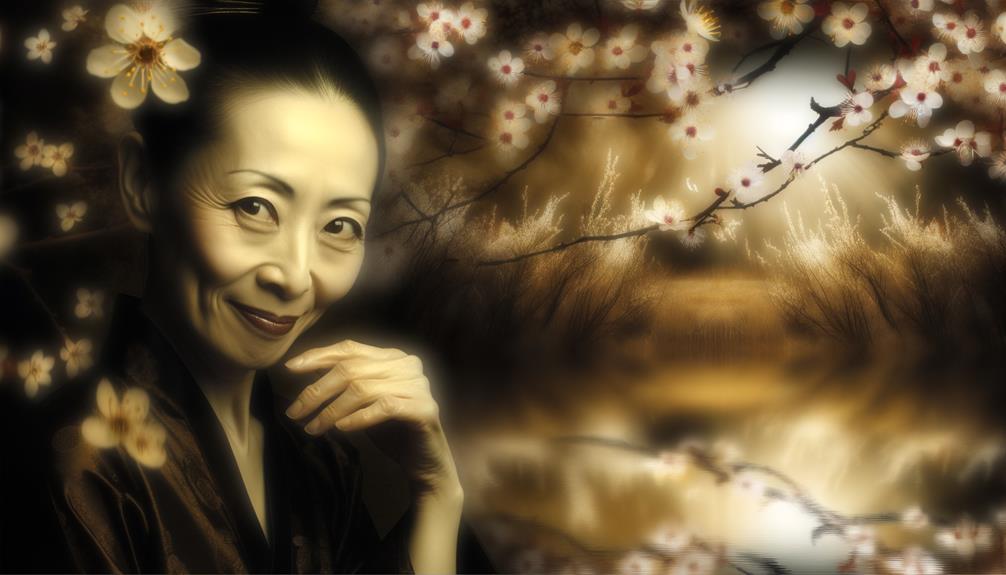Meaning of the Name Mona
The name Mona boasts a multifaceted heritage, stemming from Greek, Latin, and Old English origins. In Greek, Mona translates to 'solitary' or 'alone,' whereas in Latin, it derives from 'Monica,' meaning 'advisor' or 'noble.' The Old English interpretation connects it to the moon, invoking celestial symbolism.
Historically, it was linked to the Druidic worship at the Isle of Anglesey and immortalized through art by da Vinci's Mona Lisa. Various cultures embrace Mona differently; Arabic views it as 'wishes,' while Irish link it to nobility.
Discover more nuances and its global significance further ahead.

Key Takeaways
- The name Mona derives from Greek, Latin, and Old English origins, meaning 'solitary,' 'noble,' and 'moon,' respectively.
- In Arabic, Mona signifies 'wishes' or 'desires,' symbolizing aspirations and dreams.
- In Irish culture, Mona is interpreted as 'noble' or 'aristocratic,' reflecting a high social status.
- The name Mona is historically significant, linked to the Isle of Anglesey and immortalized by the Mona Lisa painting.
- Mona's popularity has fluctuated but remains a classic name with rich cultural and historical associations.
Etymology and Origins
The name Mona, derived from diverse linguistic roots, has a complex etymology that traces its origins to various ancient cultures, including Greek, Latin, and Old English.
In Greek, Mona stems from 'monos,' meaning 'solitary' or 'alone,' reflecting a sense of individuality. Latin offers a different nuance, where 'mona' is an abbreviation of 'Monica,' meaning 'advisor' or 'noble.' Old English also contributes, where 'Mona' signifies 'moon,' evoking a celestial and ethereal quality.
This multifaceted etymology underscores the name's rich historical tapestry, demonstrating its evolution through multiple languages and cultural contexts.
Such diversity in origins reflects the adaptability and enduring appeal of the name Mona across different eras and societies, making it a name of profound depth and resonance.
Historical Significance
Building on its rich etymological roots, the historical significance of the name Mona can be observed through its presence in various cultural and historical narratives, reflecting its longstanding impact and reverence across different societies.
In ancient Roman times, Mona was associated with the Isle of Anglesey, known as Mona by the Romans, which was a significant center for Druidic worship. This connection highlights the name's early cultural importance.
Moreover, Mona Lisa, the renowned painting by Leonardo da Vinci, underscores the name's enduring legacy in art history.
The name's usage by notable historical figures and in significant texts over centuries further cements its historical relevance, demonstrating its persistent influence in shaping societal and cultural identities.
Mona in Different Cultures
Frequently recognized across diverse societies, the name Mona holds distinct and multifaceted meanings that reflect the cultural values and historical contexts of each region. In Arabic, Mona means "wishes" or "desires," embodying aspirations and dreams. In Irish culture, Mona is derived from Muadhnait, meaning "noble" or "aristocratic." The Italian interpretation often links to "Monna," a term of respect akin to "madam" or "lady." Meanwhile, in Scandinavian countries, Mona is considered a diminutive of Monika, meaning "advisor."
| Culture | Meaning |
|---|---|
| Arabic | Wishes, Desires |
| Irish | Noble, Aristocratic |
| Italian | Madam, Lady |
| Scandinavian | Advisor (diminutive of Monika) |
Understanding these cultural nuances provides a deeper appreciation for the name's rich, global significance.
Mona in Art and Literature
The name Mona has been immortalized in art and literature, most famously through Leonardo da Vinci's iconic painting, the Mona Lisa, which has become a symbol of enigmatic beauty and cultural significance.
In modern literature, the name continues to evoke a sense of mystery and depth, often used to denote complex and multifaceted characters.
This cultural symbolism of Mona underscores its enduring impact across various artistic and literary domains.
Iconic Mona Lisa Painting
Leonardo da Vinci's 'Mona Lisa,' one of the most enigmatic and celebrated paintings in art history, has captivated scholars and enthusiasts alike with its intricate details and profound expression.
Painted between 1503 and 1506, the portrait is renowned for its subtle use of sfumato, creating a lifelike and ethereal quality. The subject's mysterious smile and direct gaze have sparked countless interpretations and debates.
Historically, the painting's provenance remains a subject of intrigue, with da Vinci transporting it to France, where it now resides in the Louvre Museum. The 'Mona Lisa' exemplifies Renaissance ideals of humanism and realism, encapsulating a moment of serene introspection that continues to inspire and perplex viewers worldwide.
Mona in Modern Literature
In modern literature, the name Mona often evokes a sense of mystery and depth, drawing from its rich historical and artistic associations. Writers leverage the name to imbue their characters with an enigmatic quality, often linked to the iconic Mona Lisa, whose inscrutable expression captivates and confounds.
This literary usage can be traced back to the Renaissance, where Mona became synonymous with an idealized, almost otherworldly femininity. Contemporary authors continue this tradition, employing Mona as a symbol of complexity and allure.
In novels and poetry, the name frequently appears in contexts that suggest hidden layers and profound inner life, reinforcing its timeless appeal and multi-faceted resonance within the cultural lexicon.
Cultural Symbolism of Mona
Throughout history, the name Mona has transcended its etymological origins to become a potent cultural symbol, particularly through its embodiment in art and literature.
The most iconic representation is Leonardo da Vinci's 'Mona Lisa,' a masterpiece that has captivated audiences for centuries. The enigmatic smile and mysterious aura of the painting have made Mona a symbol of feminine mystique and artistic genius.
In literature, Mona is often depicted as a character embodying grace, complexity, and allure, reflecting the nuanced portrayals found in classic and contemporary works.
This cultural symbolism underscores the name's enduring resonance, as it continues to inspire and intrigue, weaving a rich tapestry of meaning that extends far beyond its linguistic roots.
Popularity Over Time
Examining the historical data, the name Mona has experienced fluctuating levels of popularity across different eras and regions. In Europe, particularly during the Middle Ages, Mona was relatively common, reflecting its roots in Old English and Gaelic traditions.
The Renaissance period saw a decline, but the name resurged in the 19th and early 20th centuries, corresponding with Victorian and Edwardian naming trends.
In the United States, Mona reached its peak in the 1930s and 1940s, influenced by cultural figures and increasing immigration. However, its popularity waned in the latter half of the 20th century.
Recent decades have seen a modest revival, possibly due to a renewed interest in vintage and classical names. Overall, Mona's popularity trajectory is marked by significant cultural and temporal influences.
Famous People Named Mona
Several notable individuals named Mona have made significant contributions across various fields, enhancing the name's recognition and cultural significance. From the arts to academia, these Monas have left indelible marks on their respective domains.
| Name | Field | Contribution |
|---|---|---|
| Mona Lisa | Art | Iconic painting by Leonardo da Vinci |
| Mona Siddiqui | Academia | Renowned scholar in Islamic studies |
| Mona Simpson | Literature | Acclaimed author of novels and essays |
| Mona Eltahawy | Journalism | Prominent journalist and social activist |
The enduring legacy of these individuals underscores the versatile impact of those bearing the name Mona, spanning centuries and continents. Their achievements continue to inspire and elevate the name, enriching its historical and cultural fabric.
Modern Usage and Variations
In modern contexts, the name Mona has seen a resurgence in various cultures, adapting to contemporary linguistic trends while maintaining its historical essence.
Popular global variations include the Spanish 'Ramona' and the Arabic 'Muna,' each reflecting unique cultural nuances.
Analyzing these trends reveals how the name's adaptability contributes to its enduring appeal across different societies.
Popular Global Variations
The name Mona, while rooted in various cultures, manifests distinct variations and modern adaptations across different global regions, reflecting its rich historical and cultural significance. In Italy, "Mona" is often used as a short form of "Madonna," denoting reverence. In Arabic-speaking countries, "Mona" (مُنى) translates to "wishes" or "desires." Meanwhile, in Ireland, it is derived from the Gaelic word "Muadhnait," meaning "noble." These variations underscore the name's versatility and cultural depth.
| Region | Variation | Meaning |
|---|---|---|
| Italy | Mona | Short form of Madonna |
| Arabic Regions | مُنى (Mona) | Wishes, Desires |
| Ireland | Muadhnait | Noble |
This table illustrates how the name Mona adapts to diverse cultural contexts, enriching its global appeal.
Contemporary Name Trends
As the name Mona carries its rich historical roots into the present, it continues to evolve, reflecting contemporary naming trends and cultural shifts across different societies.
In modern contexts, Mona demonstrates a versatility that transcends its traditional boundaries. This adaptability is evident in the various creative spellings and hybrid forms that have emerged, such as Monna and Moana, the latter gaining popularity due to cultural phenomena like Disney's film 'Moana.'
Additionally, the name's simplicity and melodic quality make it appealing in a multicultural world, where ease of pronunciation and global resonance are increasingly valued.
In some regions, Mona has also seen a resurgence as part of a broader trend toward vintage and classical names, underscoring its enduring appeal.
Conclusion
The name Mona, rich in etymology and cultural resonance, has traversed historical epochs and geographical boundaries. Its significance spans from ancient linguistic roots to modern adaptations, reflecting its enduring appeal.
Mona's presence in art and literature, coupled with its fluctuating popularity, underscores a timeless allure. As a moniker borne by notable figures and adapted across various cultures, Mona epitomizes both tradition and evolution, a name that dances through the annals of time, ever graceful and compelling.






